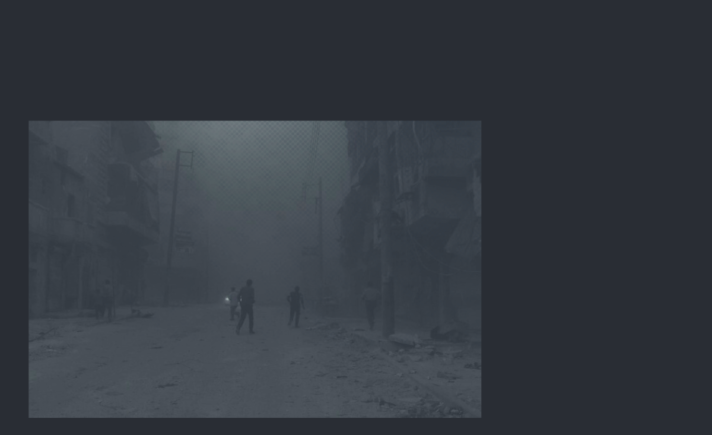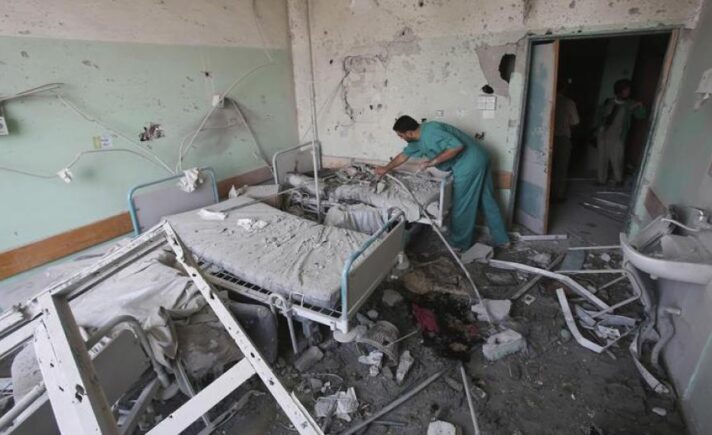On Wednesday, the member states of the Organization for the Prohibition of Chemical Weapons (OPCW) voted to strip Syria of its voting rights at the UN-backed chemical weapons watchdog, in response to its repeated failure to comply with the OPCW’s decisions. It is a symbolic move in a symbolic month; one laden with memories of chemical attacks on the Syrian towns of Khan Shaykhun and Douma in April 2017 and April 2018, respectively. For myself personally, as a Syrian medical professional and eyewitness to previous chemical attacks in the country, it is the latest in a long line of disappointments with regards to serious accountability for Bashar al-Assad’s exhaustively-documented chemical atrocities.
After the major chemical attack on Damascus’ Ghouta suburbs on 21 August 2013, the entire world went on high alert, with the drums of war against the Syrian regime seemingly beating. President Barack Obama had spent the preceding year repeatedly threatening to retaliate with military force in the event that Assad crossed his “red line” by using chemical weapons, reiterating that Assad had lost all legitimacy whenever asked about Syria. I was in Ghouta myself at the time. We medical workers were utterly exhausted, especially as we had to deal—on top of all our medical work—with media enquiries, journalists, international committees, and communications with diplomats and foreign ministries. We could barely breathe. I remember vividly how I contacted my family in the heart of Damascus and advised them to prepare our home for possible military strikes: “Stick film on the windowpanes. Keep plenty of candles and drinking water containers. Electricity and water may be cut off for long periods. Make sure to have a first-aid kit, canned food, and other dry food supplies.”
We felt an inevitable event was heading for Damascus; not one we had wished for, but a necessary evil nonetheless. We wanted the regime uprooted by any means necessary. Within days, however, there appeared the prospect of a political deal between Obama and Assad, brokered by Russia. The drums of war fell silent. While no one had wished for war, this deal involved no punishment of any kind for the flagrant use of banned weapons of mass destruction. All Assad had to do was agree—disingenuously—to dispose of his chemical arsenal, and join the Chemical Weapons Convention. It was a green light for further attacks. We Syrians had been made victims twice: first of Assad’s chemical attacks, and second of Obama’s non-existent “red lines.”
Chemical weapons and the bombing of hospitals
On 4 April 2017, the Assad regime concluded a series of chemical attacks in the countryside north of Hama and south of Idlib with a strike using the nerve agent Sarin on the town of Khan Shaykhun, killing more than 90 people and injuring over 500. The attacks had begun a few weeks previously, with a chemical strike on a hospital in al-Lataminah on 25 March, killing the doctor Ali Darwish while he was in the operating room.
On 2 April, two days before the Khan Shaykhun massacre, regime forces subjected the National Hospital in the city of Ma’arrat al-Nu’man to heavy bombardment, rendering it inoperative, despite its large size and solid construction. Ma’arrat al-Nu’man was the city nearest to Khan Shaykhun. It appeared the regime had deliberately taken it out of service in order to maximize casualties when it struck Khan Shaykhun two days later.
For Syrians, chemical weapons conjure up images of white burial shrouds lain over rows of corpses; of children asphyxiating; mothers weeping; and empty words from politicians. In the background, there is always a hospital, which is a victim too: bombed, depleted, and helpless against the sheer horror of the crime.
The military context
Almost exactly one year later, on 7 April 2018, Assad’s forces dropped munitions loaded with a chlorine derivative near the Douma Hospital, northeast of Damascus. Medical personnel had reinforced the building with complex and sophisticated fortifications. It was located in Douma’s al-Masaken area, just a few kilometers from the well-known Damascus Countryside Public Specialist Hospital in the city center. At the time, the Eastern Ghouta region and its major urban centers were being pummeled in a brutal military campaign that saw more than 25 documented air strikes on medical facilities over the course of three months, alongside attacks with chemical weapons. The largest and deadliest of these was the 7 April massacre in Douma, which caused 43 deaths and over 500 injuries.
Chemical attacks against residential communities in Syria often occur against the backdrop of military campaigns in the local region at the time. Large chemical strikes are typically preceded by a series of lighter air strikes. Each time, infrastructure and service facilities—especially hospitals—are heavily targeted. This has been particularly true since Russia’s direct military intervention in Syria began in 2015, after which attacks on medical facilities became a deliberate military tactic, aimed at paralyzing local medical sectors during military campaigns.
International efforts
No fewer than three UN Security Council Resolutions have been issued with regards to chemical weapons use in Syria. The first was Resolution 2118, issued at the end of September 2013, in the wake of the infamous Ghouta massacre the previous month. It formalized the agreement between Moscow and Washington that sought to defuse political tensions in exchange for Syria acceding to the Chemical Weapons Convention (CWC) and disposing of its chemical arsenal under the supervision of the UN and OPCW. Article 21 of the Resolution contained language suggesting the possible use of measures under Chapter VII of the UN Charter in the event of further violations in Syria.
It took no more than a few weeks for the regime to violate this Resolution and the CWC, attacking the Damascus neighborhood of Jobar with chemicals in November 2013. Similar attacks followed, some producing new symptoms in their victims, such as the strike on Harasta, next to Douma, in March 2014. It soon became clear the regime was using new chemicals—especially chlorine, first used to deadly effect in the trenches of World War I. 2015 saw the largest number of chemical attacks, with at least 69 in that year alone. On the ground, Resolution 2118 had done nothing but further encourage the use of chemical weapons in Syria. More than 77% of all chemical attacks took place after the Resolution was issued.
At the time, there was widespread discussion about which particular substances were being used in these strikes. I had thought this discussion—which struck me as missing the point—was merely local. Every new attack brought the same question about whether it had involved Sarin, or perhaps a related organophosphate compound, or else chlorine. Personally, I was surprised that the UN Security Council was taking on the role of a chemistry teacher, explaining to the world that chlorine was banned as a weapon under Resolution 2118; a point it reiterated explicitly by issuing Resolution 2209 of 2015. This new Resolution contained nothing new whatsoever with regards to accountability or responsibility for the ongoing chemical crimes in Syria; all it did was state the basics of chemical warfare by explaining that chlorine was also an internationally-banned weapon.
Five months later, in August 2015, the Security Council issued Resolution 2235, which created a Joint Investigative Mechanism (JIM) tasked with monitoring the use of chemical weapons in Syria and—crucially—identifying the entities responsible for such use. Over the next two years, the JIM issued seven reports, making abundantly clear the Assad regime’s responsibility for chemical attacks, and setting out in meticulous detail the precise military bases used for four such attacks. The JIM also established that Islamic State (ISIS) jihadists were responsible for one chemical attack. Yet the clear indictment of the Syrian regime was sufficient for Russia to intervene and use its veto power to terminate the JIM’s mandate in November 2017.
In early 2018, France decided to think outside the box of the Security Council, and announced an initiative for an international partnership against impunity for the use of chemical weapons. More than thirty countries attended its founding conference in Paris. The partnership called for strengthening the role of existing investigating bodies, and for sanctions to be imposed against those responsible for chemical attacks in Syria.
In parallel, new efforts were also underway within the OPCW to take decisions and measures against chemical weapons use in Syria. These efforts culminated in the OPCW going beyond its merely technical role; limited to investigating the facts of chemical weapons use and determining the substances used, and so on. It now assumed new powers to assign culpability and identify perpetrators, which was unprecedented for the organization. Thus was the OPCW’s Investigation and Identification Team (IIT) established in June 2018. Its first report, issued April 2020, found the Assad regime responsible for three chemical strikes in the northern Hama countryside in March 2017. Its second report was released just this month, finding the regime responsible for an attack in the town of Saraqib on 4 February 2018.
In July 2020, based on the findings of an IIT report, the OPCW Executive Council gave Syria a period of 100 days to share all outstanding information about any activities related to chemical weapons, including data on stockpiles, use, transportation, and anything else. When the 100-day deadline expired, the OPCW’s director-general reported that the Assad regime had failed to cooperate. It was for the purpose of deciding what action was to be taken in response that the OPCW member states met today.
Investigative bodies
In summary, from the first use of chemical weapons in Syria in 2012 to the present day, the following five official entities have investigated it:
1. The Independent International Commission of Inquiry on the Syrian Arab Republic (COI) established by the UN Human Rights Council. It issued an info-graphic map outlining the Assad regime’s responsibility for 22 chemical attacks;
2. A separate UN Commission of Inquiry, formed specially by the UN secretary-general in 2013 to investigate chemical incidents in Syria. It issued a report detailing the Ghouta attack of 21 August 2013, without assigning responsibility to any party in Syria;
3. The Fact-Finding Mission (FFM) established by the OPCW in 2014, which has investigated numerous incidents of chemical weapons use, issuing 24 reports thus far. It does not have the power to assign blame to any party; instead, its role is limited to verifying the occurrence of attacks and determining the substances used;
4. The Joint Investigative Mechanism (JIM) established by the UN Security Council in August 2015 through Resolution 2235. It issued seven reports over the course of two years, including one holding the Assad regime responsible for the Khan Shaykhun massacre, and another finding ISIS responsible for a separate incident. In October 2017, Russia vetoed the renewal of the JIM’s mandate;
5. The Investigation and Identification Team (IIT) established by the OPCW to operate in parallel with its FFM, but endowed with the additional power to assign responsibility for attacks. To date, it has issued two reports, finding the Assad regime responsible for four chemical attacks.
Non-governmental efforts
In October 2020, more than seven years after the Ghouta atrocity of August 2013, and over three years on from the Khan Shaykhun massacre of April 2017, three NGOs filed a complaint with the German Federal Public Prosecutor on behalf of a group of victims regarding the use of chemical weapons in Syria. These NGOs were the Syrian Center for Media and Freedom of Expression; the Syrian Archive; and the Open Society Justice Initiative. Five months later, the NGOs filed another complaint with the French public prosecutor. A third was filed earlier this month in Sweden. The complaints contained full-fledged investigations, with witness testimonies, visual evidence such as photos and video footage, a chain of command detailing the names and ranks of Assad regime personnel accused of involvement, and the names of the security and military entities responsible for developing Assad’s chemical arsenal and carrying out the strikes. These NGOs have been compelled to build these cases due to the lack of any effective alternative mechanisms for indicting the perpetrators identified in each investigation. Though no action has yet been taken beyond the filing of the complaints, aside from the opening of investigations by the German public prosecutor, they remain a very important and unprecedented step.
While working at the Syrian Center for Media and Freedom of Expression, I had the opportunity to learn about some of the efforts undertaken to prepare legal cases, and about the ongoing discussions among human rights organizations regarding the actions states could take. Proposals varied in this regard, from the formation of a court or other joint litigation mechanism among several countries, to the possibility of seeking the International Court of Justice or International Criminal Court. For years, Syrian organizations have had to play a hugely outsized role, starting with documenting violations and providing information to international investigative bodies after the completion of several verification steps. They have essentially been the sole pair of eyes for human rights on the ground, given how rarely UN agencies and international investigators have had access to the sites of attacks. They have had to develop their own methods, tools, techniques, and mechanisms to cope with the extremely difficult security situation. They have even had to analyze laws, international treaties, and executive measures to search for a course of action that might potentially lead to the indictment of perpetrators.
In 2018, during a sample collection exercise, we were divided into teams to carry out practical training simulating the conditions of chemical strikes. Different types of chemicals activated certain sensors, allowing us to train using our detection devices. An important aspect of this training was the wearing of protective gear, followed by its decontamination and removal in a manner that would not permanently contaminate the area. On my team were a surgeon, two pharmacists, and myself, a dentist. The mask limits your movement, your ability to breathe comfortably, even your ability to see. During the training, I glanced at my colleagues’ eyes, as though to say: Where are we? Why are we here? Why are we doing this? Why should we, a group of medical practitioners, be trained to collect chemical samples? Is this really our place? Did we really have to lose Dr. Ali Darwish in a chemical strike? Wouldn’t it be better for us to be part of teams building Syria’s healthcare sector? Have the options really been exhausted to the point that doctors are being trained to collect these samples, and human rights activists are studying the legal ways to punish the perpetrators of a crime for which they have been proven responsible again and again by multiple parties? Would all this be happening were it not for Obama’s red lines?
Pro-regime propaganda
Since 2012, the Assad regime’s response to accusations of it perpetrating chemical attacks has taken two main forms. The first is total denial of the occurrence of any attack at all, with accompanying accusations that the opposition or humanitarian organizations have fabricated everything. Who could forget Assad’s media advisor Buthaina Shaaban asserting that children had been kidnapped and turned into crisis actors to stage the Ghouta massacre? The second form of response was to acknowledge that chemical attacks had taken place, but to accuse the regime’s opponents of having carried them out themselves. Great efforts in this regard were undertaken by the regime and its media machine, and then by the Russian government, which later took the lead in this disinformation campaign.
The chlorine attack on Douma in 2018 was a landmark moment for the Russian propaganda machine. Moscow went as far as to create a dedicated group to intimidate witnesses, headed personally by Colonel Alexander Zorin, a leading figure in the negotiation of local agreements in Syria. This Russian propaganda machine focused chiefly on the following activities:
1. Witness intimidation: This was done primarily with phone calls via medical staff members who had been recruited for the purpose. Witnesses to the chemical attacks were threatened with harm to their relatives living in areas under the Assad regime’s control in the event that they gave any evidence of attacks having taken place;
2. Attempts to undermine the credibility of investigations: These particularly targeted the OPCW, compelling the latter to publish a detailed report refuting the spurious accusations leveled against it;
3. Political pressure on investigative bodies: A notable example was when the COI refrained from including its findings regarding the Douma chemical attack in its periodic report issued in July 2018. The COI redacted the relevant pages at the last minute;
4. Fraudulent testimony before the OPCW: In 2018, the Russian mission to the OPCW hosted fake witnesses in The Hague. The OPCW’s director-general objected that investigators were supposed to interview witnesses before they could be involved in this manner. The Russians, however, proceeded regardless, making it clear that the entire charade was a media stunt.
A return to pre-2013?
Syria’s chemical attacks paint a clear picture of the criminality of the Assad regime, which saw nothing in Obama’s illusory red lines—or the Security Council’s toothless Resolutions—except a green light for yet more atrocities and massacres. First, there was the 2013 Ghouta attack, with its horrific number of victims; then the series of strikes in the countrysides of Hama and Idlib between 25 March and 4 April, 2017, beginning with the attack on al-Lataminah Hospital and ending with the Khan Shaykhun massacre, with all that these entailed in terms of the destruction of healthcare facilities. Then came the host of strikes coinciding with the military campaign on Aleppo, in which chemicals were used against certain sites that proved difficult for Assad’s war machine to destroy by other means, including hospitals, such as the “M10 Hospital” strike in early October 2016. These culminated in the Douma massacre of April 2018, which saw strikes on the hospital’s surroundings and entrances. Even though victory was imminent for the regime, its insatiable appetite for violence prompted it to commit yet another chemical atrocity, and then activate a machine of propaganda and witness intimidation to cast doubt on independent investigations and attack the credibility of investigative bodies, to the extent of exerting political pressure on these bodies to water down their findings and hesitate to assign responsibility.
In over eight years of following this issue, engaging with it, and reaching dead ends every time; and as a direct witness to chemical strikes when I was in Syria before 2014; in addition to later contact with witnesses and investigative bodies, and my involvement in documenting and responding to the use of chemical weapons; it has always been my hope that real action will one day be taken to hold Assad to account (beyond the handful of missiles President Trump lobbed at Assad’s infrastructure after the Khan Shaykhun and Douma massacres in 2017 and 2018, respectively). It appears, however, that we continue to bear the legacy of Obama’s red lines, and that Western state actors, led by the US, are equal in responsibility—at least ethically—to Russia, which directly supported the regime, in light of their approval of the deal concluded in September 2013 between Washington and Moscow.
During an advocacy trip, after meeting with several US Congress members, an intern and political science graduate from an American university came to chat with us as we walked outside. At the time, we were trying to push a group of states to adopt serious measures against the bombing of hospitals in Syria. The intern told me, “If I were in your shoes, I would try to pressure against the use of chemical weapons. Few countries are involved in chemical weapons use, and it’s a stick everyone would love to use, whereas all the states being pressured against the bombing of hospitals are themselves involved in bombing hospitals somewhere; if not in Syria then in Afghanistan, Yemen, Iraq, or elsewhere.”
Today, I remember that person’s words, and feel these states wish for no more than merely to wave that stick; that the most they are willing or able to do is suspend Syria’s membership of the OPCW. In the event, they did not even go that far. Meanwhile, medical workers and human rights NGOs will be left to persist in their efforts to break rocks with their bare nails, while witnesses will continue to fear they are risking their safety and that of their families in vain, so long as the world’s most powerful states do nothing more than strip the Assad regime of its voting rights in an international organization it never wanted to join in the first place.
[Editor’s note: This article is published in cooperation with the Don’t Suffocate Truth campaign. It was originally published in Arabic on 12 April 2021. It has been updated in English to reflect recent developments.]








